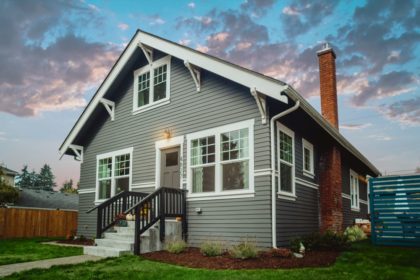
If you’re looking to make a dramatic change to your home, updating your windows is a great option! Our previous home was purchased with the original 1970s, aluminum framed windows. They were anything but airtight and incredibly dated. We upgraded them to vinyl and were amazed at how they changed the look of our home, inside and out!
I know, windows don’t sound like a ‘fun’ place to spend your money, but it is a great investment considering windows are key for protecting your home, keeping hot/cool air in (and out!), and adding value to your home. Before you jump in to upgrading your windows, make sure you know the 4 differences between vinyl and wood windows.
First, let’s decide which is the best material option for you.
Vinyl windows are made of polyvinyl chloride, commonly known as PVC. PVC is a plastic material that is also used to make plumbing pipes, electrical pipes, and other plastic items. Unlike the first generations of vinyl windows, you can now get them in an array of colors. Take your time in deciding on a color, vinyl windows have a life expectancy of over 20 years! Vinyl windows are also more affordable, which is why they are in high demand and you see them frequently getting installed.
Wood windows are still a great option if you’re looking to upgrade! They offer durability, energy efficiency, and can have a longer life span than vinyl windows if they are maintained properly. Wood windows are best for visual appeal. They are often used in historic homes and homeowner associations. A quick note, if your windows do not have an exterior clad, you will be repainting every few years.
1. Energy Efficiency
Vinyl is a good insulator as it does not conduct heat or cool air. However, most vinyl window frames are hollow, which makes it easier for cold air to pass through.
Wood is one of the best materials for insulation as it inhibits both heat and cold transmission.
If you are basing your decision fully on energy efficiency, it would be a tough decision to make. Both vinyl and wood windows perform similarly, so you’ll have to consider something else when you’re selecting your windows.
2. Installation
Wood is more complicated than vinyl to install. Wood windows may require modifications on site to fit into existing window openings. They are also heavier than vinyl, which means they will require more people and more cash out of your pocket. Wood windows also require additional finish work: sanding, staining/painting, and installing an exterior clad if needed.
Vinyl windows are typically quicker and easier to install because they are lighter and don’t require as much finish work as wood. If you are planning on replacing your own windows, vinyl is the way to go.
3. Maintenance
Wood windows will require exterior maintenance every 3-4 years, depending on your climate. Keep in mind, when you are constantly painting and restaining your windows, you’ll also need to remove the paint or clean off the varnish every few maintenance years to avoid paint build up. You will also have to check your wood windows more frequently for damage from pests and weather. If your wood windows are cladded, you can avoid some of the maintenance involved.
Unlike wood windows, vinyl windows require very little upkeep and maintenance after they are installed. Simply wash your windows once a year (inside and out!) and perform small touch up cleanings as needed.
4. Costs
According to the 2019 Cost vs Value Report, vinyl windows are a better buy. The average vinyl window replacement costs around $4,000 less than replacing with wood windows. Vinyl windows also recuperate more of your investment in the long run. Wood windows recuperate 71.5% of their cost, while vinyl windows recuperate 72.3%.
Keep in mind, every replacement window project varies in cost based on a few major factors:
– Window style
– Customizations (color, grids, window hardware)
– Quantity of windows
– Quality of your contractor
We hope this helps you decide which window option is best for you and your family!